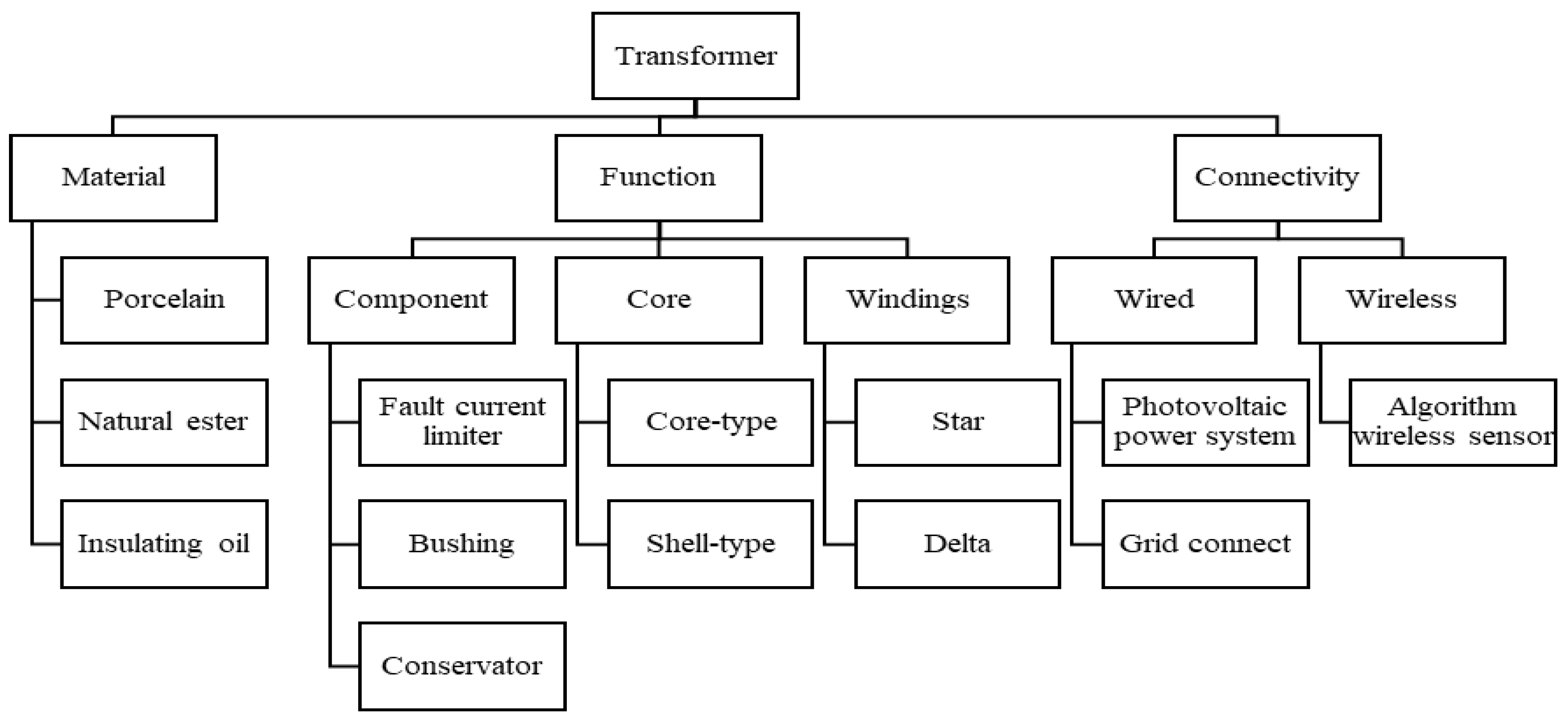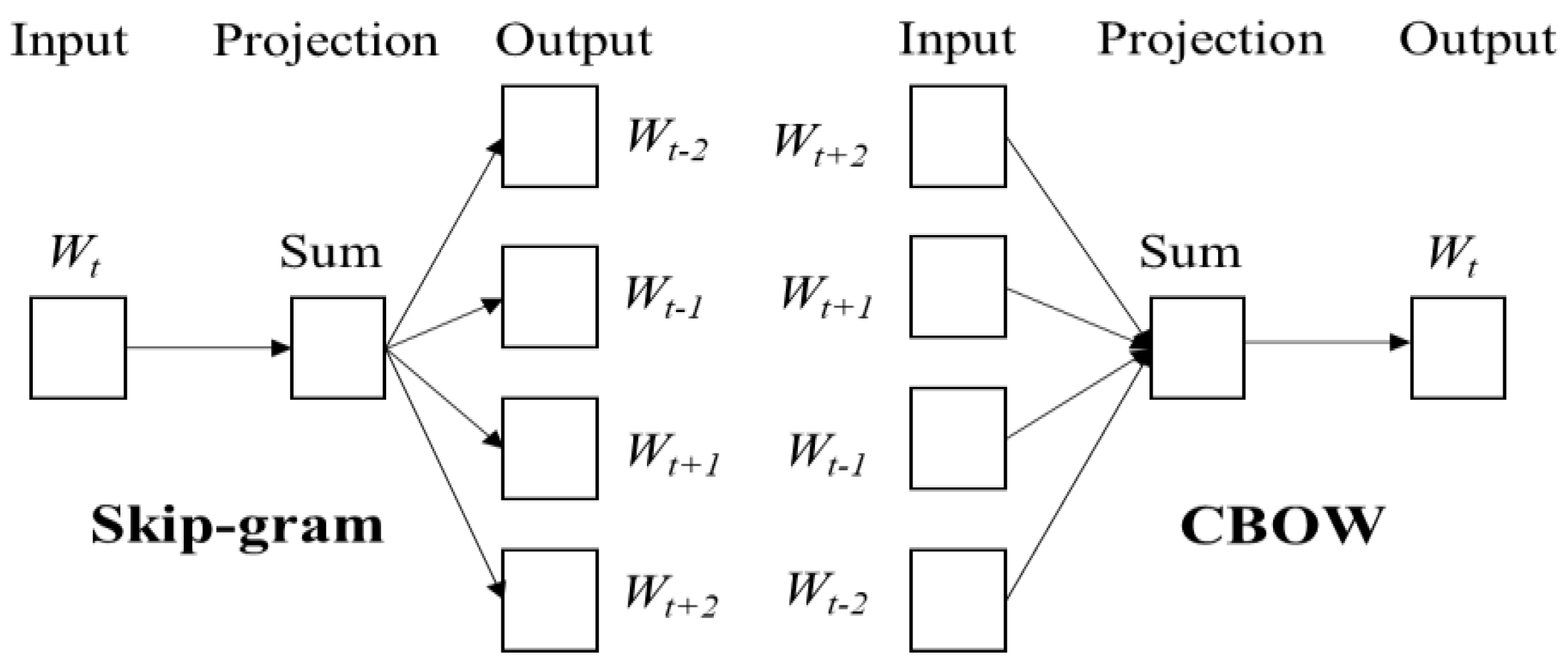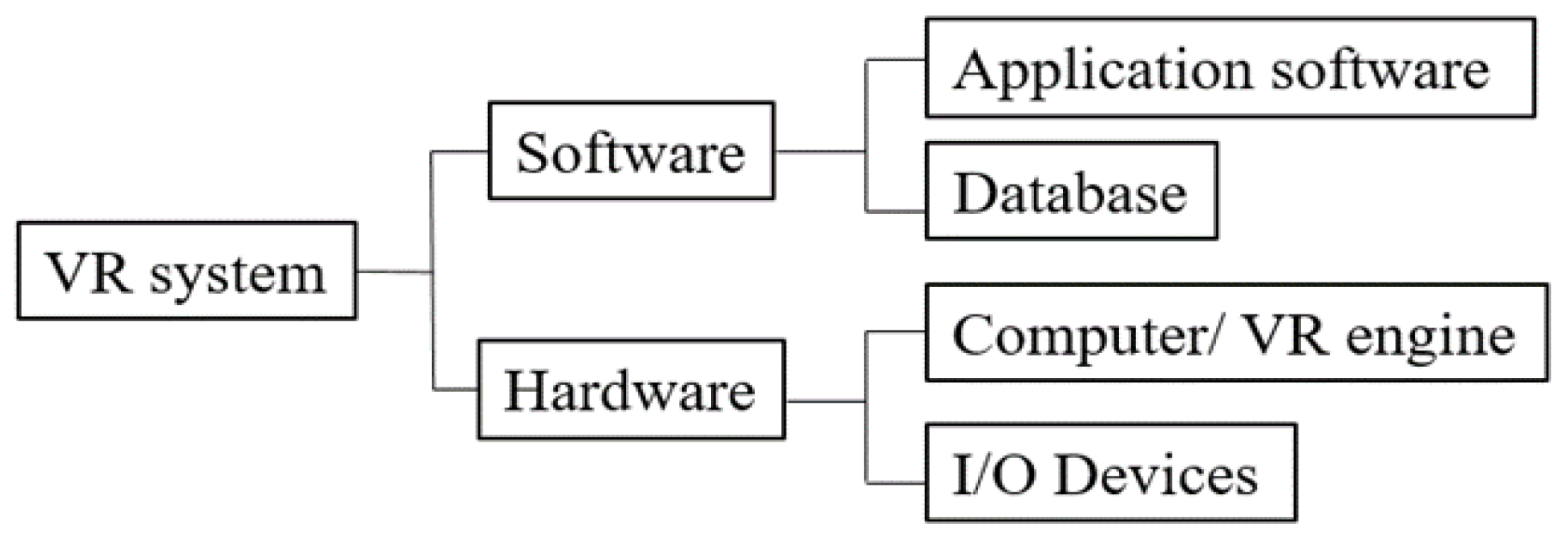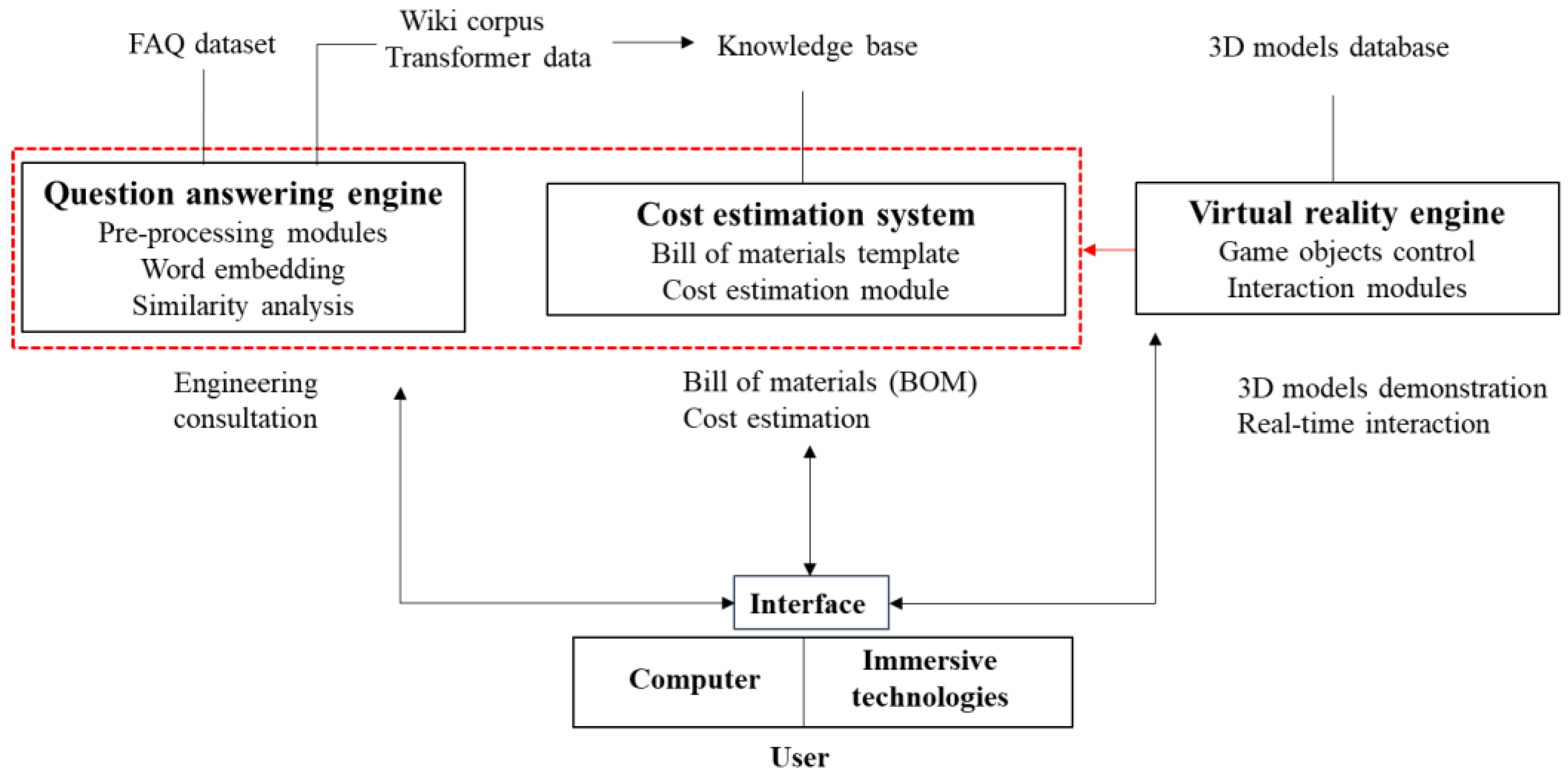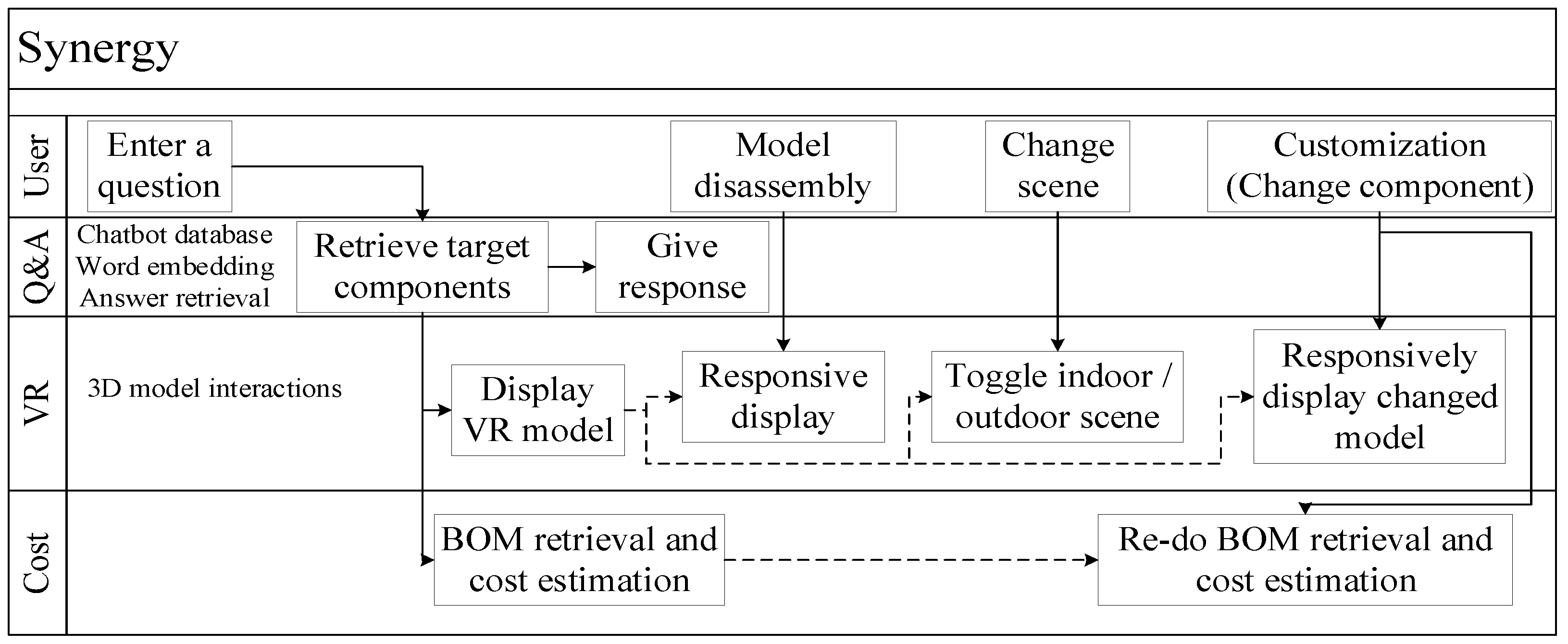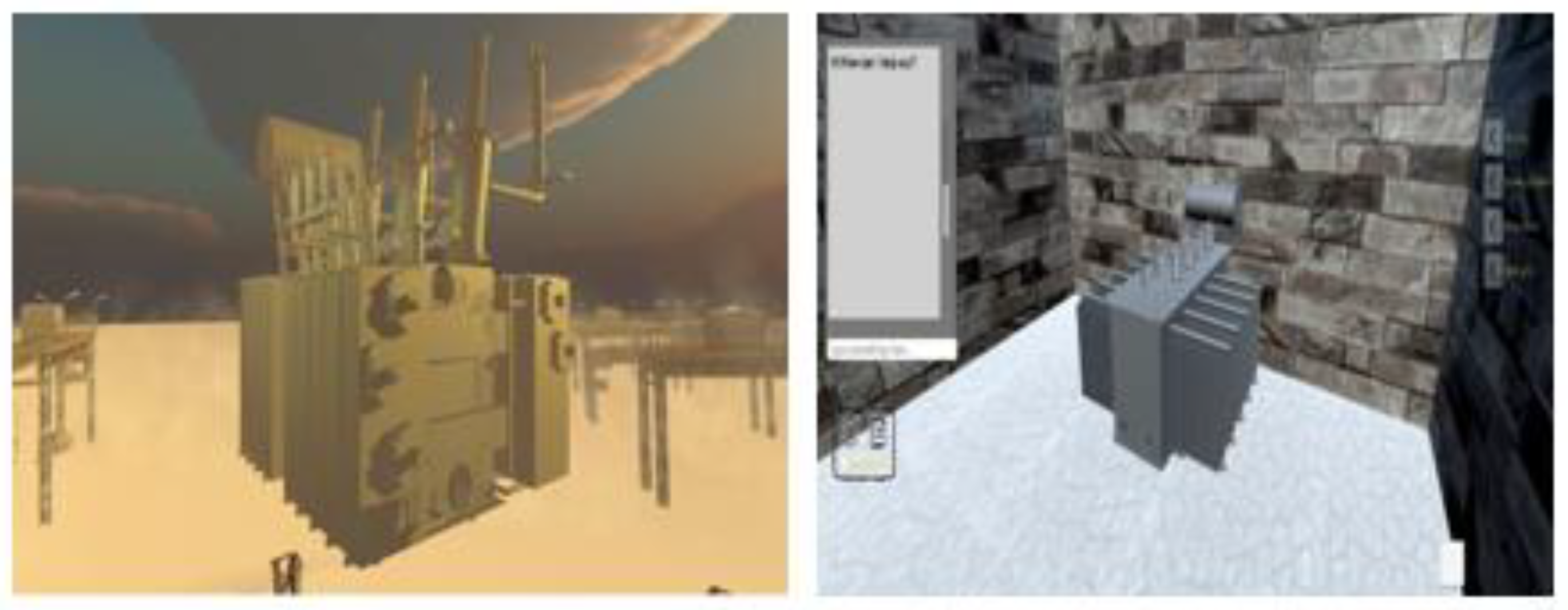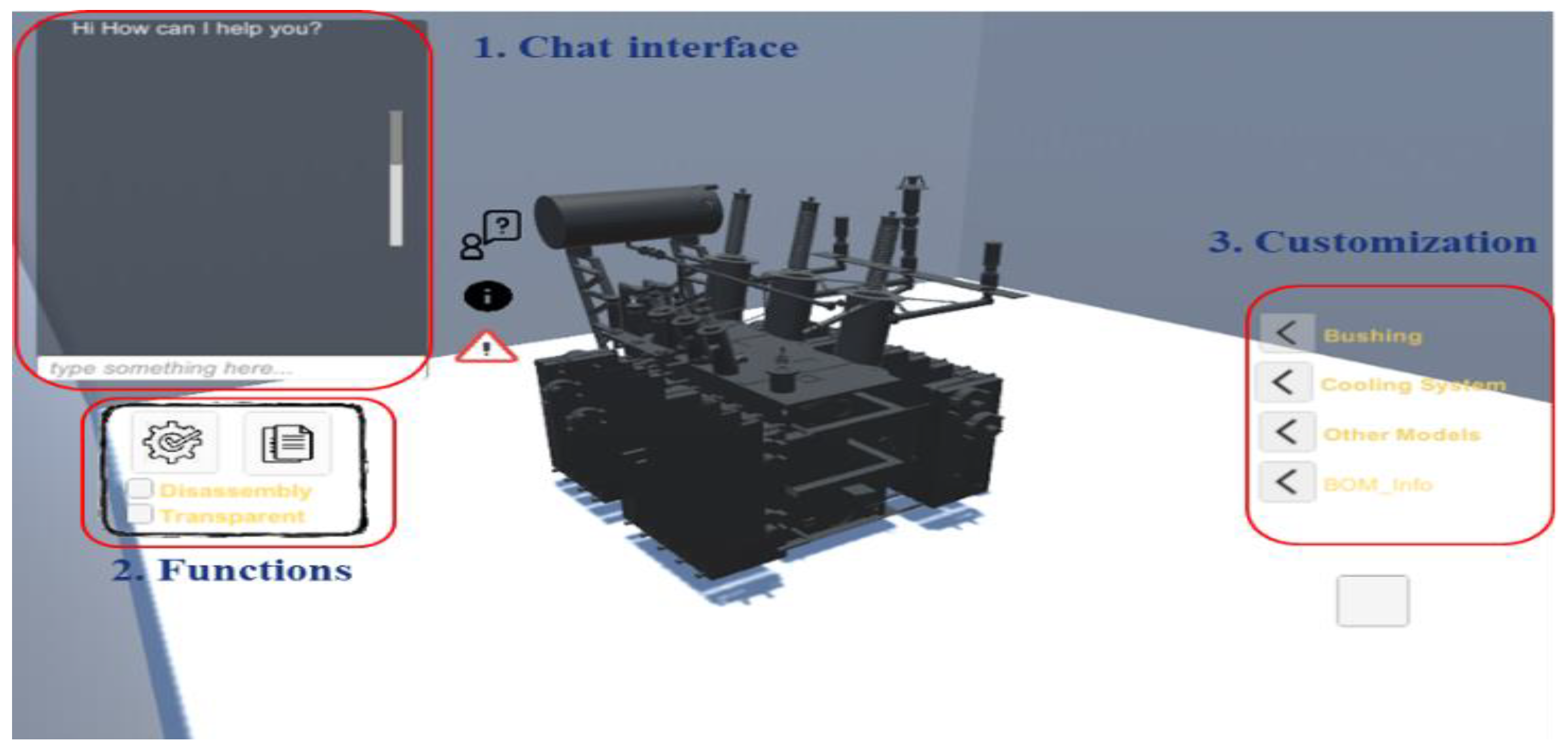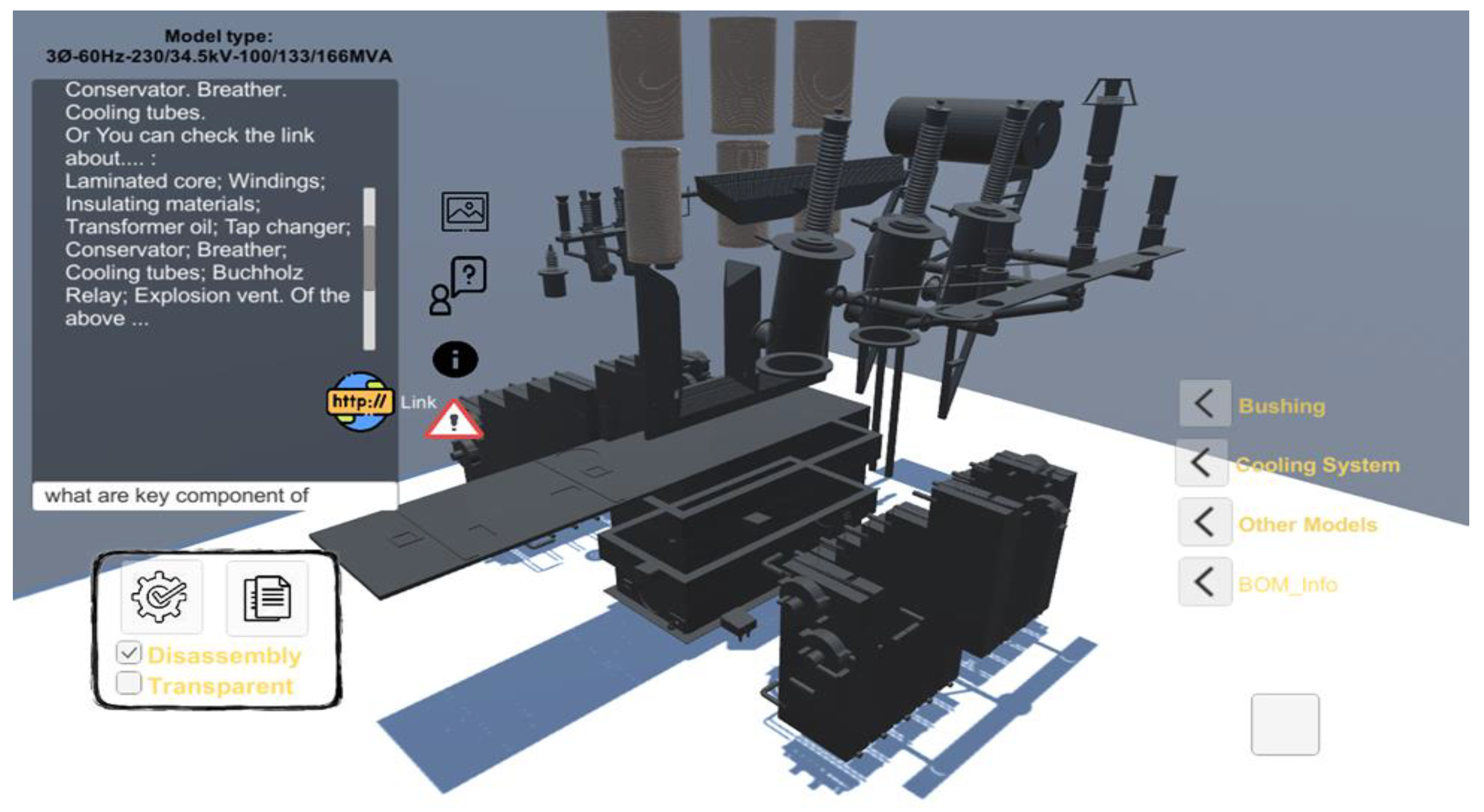1. Introduction
Large-size industrial power transformers are complex static engineering systems used for electrical power distribution to step-up voltages for transmission from power plants or distribution centers and step-down voltage levels for receiving power at end user factories, manufacturing centers, or large building complexes. A high degree of customization is required for complex industrial-grade machinery design and manufacturing of transformers due to their extensive use in all aspects of construction including large ships, wind farms, factories, large medical centers, and even shopping malls. In order to provide remote customers with highly customized machinery designs and quotations, engineering consultation services during the processes of procurement are critically important. This research develops a generic methodology and system framework for building a Virtual Reality (VR) enabled intelligent engineering consultation Chatbot system. The customer-driven transformer consultation Chatbot prototype with VR as an improved Human Computer Interface (HCI) is demonstrated using a case example in
Section 4.
Request for Quotation (RFQ) is a process where an enterprise or public entity releases purchase specifications for the manufacturing, design, and services for a product or service to a qualified vendor. Vendors then tender bids in response to the request, which often requires interaction and negotiations over key components, customization, services, and price before a vendor is selected. For non-customized products and systems, the buyer may opt to use closed bids from vendors without negotiation or consultation of design and price. The purpose of an RFQ is to provide suppliers with the specifications of the procurement item such that price quotations and warrantees for their product and services may be formulated. An RFQ generally includes the product description, quantity, delivery date, delivery location, contact person, unit price range, and whether alternative components may be used in the design. The composition of the RFQ bid must be supported by engineering knowledge data, including a Bill of Materials (BOM), manufacturing process, cost estimation, guarantees and warranties, transportation, installation, and safety inspection [
1]. For manufacturers, archived RFQs are high value engineering knowledge documents that are managed to strengthen communications with current and future industrial customers. An RFQ is a less structured text and figure-based document with design features and tables that are created from the buyer’s domain knowledge. The buyer’s knowledge may not be current with what the supplier can provide since suppliers must continuously conduct research to improve the design and lower costs to better satisfy a prospective buyer’s requirements. For large power transformers, there are few closed bids since the seller should be able to pitch their bid and explain the strategic advantage of the price, product, and service based on their latest technology and be allowed to negotiate the terms and designs to reach a solution. The vendor that provides an advanced transparent solution with the fewest issues on time and within the price range will most likely win the bid. For the specification and design confirmation stage of large-scale industrial products such as transformers, customization is widely adopted, which means that close and frequent communication between manufacturers and customers is necessary. In order to quickly answer customers’ technical questions and provide 24/7 service, a Chatbot was built into the customization stage. For this research, RFQ knowledge documents are treated as the core knowledge content for training and verifying the consultation Q&A Chatbot.
A key concept in advanced Chatbot development is to improve the buyer’s experience, especially for complicated engineering products and services involving negotiated procurement bids. In the past, enterprise customer service was a manual task requiring text messages, site sales visits, and numerous phone calls. Sellers often have insufficient and inexperienced service staff, operate under high costs, and provide poor quality service that results in frequent customer complaints and loss of sales. Over the last decade, there has been an increased need to improve service quality to maintain strategic market advantage. A result of this trend has been implementation of software as service Chatbots or “virtual assistants” across many industrial sectors [
2]. For engineering or manufacturing companies, customer service Chatbot development faces many challenges due to insufficient domain specific knowledge required for building consultation Chatbots. Knowledgeable Chatbots require high level professional linguistic capabilities to understand technical questions and provide correct answers. Intelligent consultation Chatbots are especially important for manufacturers of complex machineries to properly answer global customers’ technical questions online at any time.
For large and complex power transformers, the immersive visualization capability of a Chatbot is also needed to provide a vivid illustration of the design offered during Chatbot Q&A. Through the user’s actions in reality and the information transmitted to the virtual world, VR creates the interaction between people and the realistic virtual space with an immersive experience, thereby demonstrating great potential for various application scenarios [
3]. As reported by literature sources [
4], VR technology is the core information technology for enhancing the HCI of industrial applications used for complicated engineering modelling and intelligent manufacturing. When VR is applied to industrial training, immersion improves worker efficiency as well as safety. The combination of VR and digital twins constructs digital mirror images of 3D objects in the physical world and moves the images into virtual space. The virtual image becomes the basis for applications supporting product design, manufacturing, and commercial promotion.
In this study, an immersive interactive environment is created for the functions of component design, assembly, and disassembly in the process of customization of large-scale industrial transformers. Before the 3D model is built, a 2D engineering design layout is needed to construct a complete model that meets the desired specifications. Before the power transformer is built, the manufacturer of power transformers needs to provide an approval drawing to the customer. The approval drawing includes the transformer outline drawing, nameplate, and specification. In view of this, when the model is under construction, the structure of the approval drawing and related important equipment need to be included. The 3D product design when compared with only 2D images before manufacturing provides customers with a better visual presentation to enhance understanding of the product and to make discussions more efficiently.
Using the proposed system, the appearance and structure of industrial power transformer are presented to customers in VR interactive fashion before the RFQ document was proposed to accelerate the customization process, and customers’ questions can be answered by Chatbot with knowledge related to engineering specification, bill of material, and cost estimation about transformers. In this paper, the following objectives are achieved:
Build a retrieval-based chatbot with knowledge base containing conversation (Q&A) dataset, international standards document set, transformer components, and cost information.
Train a word embedding model and construct a similarity calculation module for chatbot information retrieval.
Construct a Virtual Reality environment that provides transformer 3D models and user interactions.
Combine a chatbot with immersive VR HCI and demonstrate the system interface.
The paper is structured as follows. In
Section 2, the literature review introduces power transformer knowledge, Chatbot technologies with natural language processing (NLP) capabilities, and VR immersive technology and applications for advanced manufacturing.
Section 3 describes the VR-enabled Chatbot system development process flow and the application methodologies such as Chatbot FAQ knowledge training, Q&A matching and retrievals, BoM-based transformer cost estimation, VR environment building, and the integration of system modules. Using the complex transformer engineering design and consultation process as the case example, the VR-enabled Chatbot prototype is described, and system scenarios are tested. The performance measurements and verification are presented in
Section 4. The final conclusions and the contributions of the research are presented in
Section 5.
3. Methodology
The methodology and framework of three sub-systems are introduced, which are Q&A chatbot, cost estimation, and VR. In
Section 3.1, the collection of FAQs and international standards, the training data preprocessing and modeling for NLP-based conversational understanding, and the Q&A retrievals are described.
Section 3.2 explains the methods of building a BOM-based knowledge base for cost estimations.
Section 3.3 describes the VR engine, 3D model building, and the VR environment development for scene design, object control, and applications on the platform.
Section 3.4 discusses the system integration of the question answer chatbot, the cost estimation system, and the VR environment.
The theoretical and practical importance of the proposed research is demonstrated by showing the challenges of designing functional VR-based consultation Chatbots that close the gap between proposed systems and actual systems being used by a power transformer manufacturer (see
Table 2). The framework of the proposed engineering consultation system framework, integrating the NLP-enabled Chatbot, the computer-supported cost estimation, and VR HCI, is shown in
Figure 5.
3.1. Chatbot Q&A System
A retrieval-based Chatbot Q&A system is adopted in this research by calculating the similarity between the user question and predefined FAQs. The Chatbot eliminates the process of reorganizing the answers and improves the efficiency of the systems accuracy of answers. The process of selecting answers in the FAQ dataset in this research can be divided into the following steps.
Pre-process questions to remove non-informative words and save computing time.
Derive word vectors and calculate the similarity between user’s question and each question in the FAQ dataset. The answers corresponding to the questions with high similarity will be returned.
Figure 6 shows the proposed Chatbot knowledge base schema in three parts. The first part is the FAQ dataset; the second part is dataset of the mapping of abbreviation and the full name of relative technical terms; and the third part is international standards.
The quality of the dataset directly affects the effectiveness of the engineering consultation. The FAQ dataset is collected from the FAQ list on webpages of power transformer suppliers. The questions include many aspects, such as transformer knowledge (equipment, specifications, materials, tests), international standards (ASCI, IEC, ISO), customer support (delivery and contact, product, company information) and engineering knowledge (mechanical engineering, electrical engineering). Engineering domains contains a large number of technical terms, in which abbreviations are collected from technical papers related to power transformers and RFQ files to establish a dataset. For example, HV means high voltage; RTD means resistance temperature detector; and OTI means oil temperature indicator.
Large-scale transformers play an important role in the industry and their design and specifications must comply with different international standards. For example, in IEEE C57.13, the performance requirements for electrical systems and test interchangeability of current and inductively coupled voltage transformers are described. The standard covers the requirements for Class 1 instrument transformers. Customers in this industry may ask suppliers questions about international standards when discussing the design of a power transformer. However, most international standards websites only provide paid document browsing, and do not have sufficient and well-organized FAQ’s for users. In order to complement the international standard answering ability in the FAQ dataset, this research collects international standards commonly used in transformer design. These standard and specification files are used to construct a structured database such that users can answer questions related to international standards through the Chatbot interface. Users can search the chapters and contents of standard files related with keywords related to specific parts or search the catalogs and preliminary contents of specific standards with standard names and chapters.
The following section explains how to search and retrieve the most relevant answers from the database. During the answer search, similarity analysis is used to calculate the similarity between the questions in the FAQ dataset and the user’s question. Before the calculation, each word in a question is converted into a vector, and the word embedding tool used in this system is called Word2Vec [
24]. Skip-gram model is used in this study since it can learn better representations for rare words then CBOW. The training data include 5 million articles or more than 40 million pages full text of Wikipedia corpus (
https://dumps.wikimedia.org/enwiki/, accessed on 24 January 2021), about 1.3 thousand RFQ documents from the power transformer industry, and hundreds of power transformer-related technical papers retrieved from IEEE. Gensim is used to train the model, which is an open-source Python toolkit for unsupervised learning. There are several parameters that can be chosen in model training. The size is set to 300, which means that the dimension of a word is 300. The large size requires more training data yielding improved accuracy. The window size is set to five, since a smaller window size gives acceptable results that are syntactically and semantically related and larger windows improve results that require more training time [
56]. The word embedding model was obtained after more than eight hours of training, and the number of words in the model’s vocabulary is about 1.2 million. After deriving the vectors of every word in a question sentence, the similarity calculation between the user’s question and questions in the dataset is conducted. Formula (1) of cosine similarity defines Ai and Bi as components of vector A and vector B respectively.
Figure 7 describes the process of similarity score calculation and response selection used for searching the FAQ dataset. The process is divided into three steps:
Obtain tokenized sentence and convert every word in the sentence into vectors using a trained Word2vec model.
Derive the average word vectors of a sentence and calculate the similarity between user’s sentence and every sentence in FAQ dataset. For example, when deriving the similarity of the two sentences: S1 (W1, W2, , Wi) and S2 (w1, w2, , wj), the first step is to derive the word vectors of each question. S1 = (VW1, VW2, ..., VWi), S2 = (VW1, VW2, ..., VWi). Then, calculate the average word vectors as a sentence vector: Vs1 = AVG(VWi) and Vs2 = AVG(VWj). As a result, the similarity of S1 and S2 will have the cosine similarity ((Vs1), (Vs2)).
After deriving the similarity score between user’s question and every question in the dataset, select the question’s prioritized answers ranked by similarity scores to provide the best answers from the dataset. The same method is used to retrieve contents from international standard files. The system compares the similarity between the titles or sub-titles of files and user questions to provide users with the most relevant content related to international standards.
3.2. Cost Estimation System
Power transformers are critical equipment for power plants and substations that are highly customized to satisfy customer needs. Manufacturers and customers must have honest and trusted communications when negotiating prices. By introducing the cost estimation sub-system, customers have a preliminary understanding of the price of the product. An RFQ in the power transformer industry is a document used to request bids from qualified manufactures of transformers. The RFQ document specifies the requirements of the transformer to be purchased.
The first task for constructing a cost estimation system is to build a knowledge base (KB). The knowledge base contains the estimated cost of all key materials or components for transformers. The cost data of a given RFQ are retrieved from the KB and put into the BOM table for instant cost aggregation. The information of the prototype knowledge base is built using a MySQL database management server [
57]. The MySQL server independent from the cost estimation program. Accessing the database through SQL makes the back-end database easier to update or replaced with existing ERP cost modules. The proposed VR consultation system uses the information stored in the MySQL server such that data are passed to the Unity environment. The Chatbot shows the cost estimation results by tagging the transformer and its components’ 3D VR modals. The BOM generation enables the customer to receive a tentative cost estimation of the transformer design when sending an RFQ to the manufacturer. These quotes are critical factors that determine product costs that enable manufacturers and customers greater flexibility in negotiations.
3.3. Virtual Reality Environment
The 3D transformer models can be accessed either by computer or in immersive way with HTC VIVE helmet and controller. The following sections introduce the modeling software used in this research and the development of Unity 3D game engine applications.
SolidWorks, the first Windows-based 3D CAD modeling software, is used in engineering design and provides a powerful platform for the design of components. SolidWorks simplifies assembly design and provides the same visualization as in the real-world, design-and-obtain functions, and allows users to view, rotate, and even enter the interior of the equipment. Unity 3D is used to construct the user interaction environment. Unity is a cross-platform game engine that enables users to create games, simulations and interactive experiences in both 2D and 3D, and the engine offers a primary scripting API in C#. The development environment of Unity is divided into scene design interface, scene object structure, object structure, object list, object attribute, and execution interface. When designing the user interface of the Unity program in this research, there are three parts: the chatbot (dialogue window), model interaction area, and the functions list.
Chatbot (Dialogue window): Users can interact with the chatbot system within a dialogue window to conduct an engineering consultation via a keyboard or microphone.
Model interaction: Users interact with 3D models in real time, and can choose key components (i.e., conservator, bushing, cooling system) to view relevant specification information in the VR environment. The specified commands to disassemble the model are used to spread out the internal core structure.
Functions list: Users may customize the components or specifications of models, such as replacing some components or toggle from indoor scene to outdoor scene.
3.4. Systems Integration
The previous sections discuss the methods and processes for constructing the three sub-systems. This section discusses how to integrate the question answer chatbot with the cost estimation system in a VR environment. The first subsystem includes a preprocessing module, a word embedding model, and a similarity calculation module. Python code is used for NLP and to build the chatbot. Python provides a rich natural language toolkit library to help with data pre-processing and word vector model training. The Chatbot can covert a user’s question into a vector and retrieve the best answers from FAQ dataset or files from the knowledgebase.
Figure 8 shows the synergy of proposed integrated chatbot. When the user enters a question, the Q&A engine retrieves possible answers and sends a response to the user. Since the chatbot is integrated with VR module, the relevant components or specification information about the power transformer is displayed on the VR model. As for the cost estimation module, the BOM of components are retrieved and the costs are estimated. The model interactions described in
Section 3.3 are also illustrated in
Figure 8, including model disassembly, indoor/outdoor scene change, and customization.
By integrating chatbot with VR and the cost estimation module, the system helps customers understand the product more comprehensively, and provides the advantages of providing real-time interaction of text and 3D models for collaborative engineering design and customer sales.
In the second sub-system, given the large number of components and materials used to build a power transformer, a relational database is used to store information in the knowledge base. The information of the knowledge base uses the MySQL database server. The information includes raw materials, specifications, and the unit cost of key components stored in the MySQL server. The data are passed back to the Unity environment of the Chatbot to generate a BOM table of the estimated cost using a Net Framework.
Figure 9 shows the proposed system connects the three sub-systems by the user interface, which is developed in Unity 3D and controlled by C# programming language.
4. Case Implementation, Verification, and Demonstration
The system provides real-time engineering consultation, an automatically generated BOM for cost estimation when receiving an RFQ summary file and provides user an immersive environment to interact with 3D models. This section discusses the implementation of the system including the introduction of functions, interface design, and verification of the consultation Q&A accuracy. The case demonstration focuses on the VR-enabled consultation Chatbot functions supporting transformer mass-customization.
4.1. Chatbot Implementation and Verification
The consultation Chatbot implementation shows that users can easily ask questions in English and receive a concise and insightful answer in real-time. The question-and-answer dataset used in this system comes from the public FAQs on the webpages of different power transformer suppliers. The answering capability of consultation Chatbot depends on the completeness and correctness of the FAQ database. Therefore, the collection of accurate data for the FAQ database is essential and must be evaluated by a domain expert. Our data were verified by an engineer from a large power transformer company. The questions include transformer engineering knowledge and customer support consultation.
Table 3 provides examples of the FAQ database.
The functions of the proposed Chatbot can be organized by three parts: answering users’ questions within the FAQs database, linking external databases to improve the accuracy of answers within the domain, and constructing an error reporting function to dynamically update and modify the database. One hundred questions are used to evaluate the accuracy rate of the proposed chatbot. The questions are collected from Quora (
www.quora.com, accessed on 24 January 2021). Adopting the concept of collective intelligence, all the questions and answers in Quora are created, edited, and organized by the engineers who will use the system. The source of the database used in this research is the FAQs collected from power transformer manufacturers, and the test questions are used to verify whether the Chatbot can answer frequently asked questions related to transformers, e.g., the relevant technologies, product specifications and service provision by manufacturers. The testing result shows that more than 85% of 150 transformer questions, randomly selected from Quora, are answered correctly by the proposed system when compared to the Quora collective answers. This system demonstrates its general knowledge capability for answering the public’s questions related to transformers. Quora’s answers are sometimes incorrect since the source is from the collective intelligence of the general public who may or may not have sufficient transformer knowledge. As for the answers in the proposed system, the Q&A dataset is sourced directly from transformer manufacturers, who are experts in the power transformer knowledge domain. The verification process of engineering consultation Chatbot performance shows that industry specific Chatbots rely on a large amount of professional knowledge to provide correct and adequate answering services. Testing data from different sources helps identify the shortcomings of the Chatbot system’s Q&A interpretation and its FAQ dataset for modification and improvement.
During engineering consultation, international customers are often concerned about compliances with international and national standards such as IEEE, IEC, and ANSI regarding transformer design and installations. Using the database established previously, in addition to being able to retrieve answers from the FAQs dataset, the chatbot provide users with content relevant to international standard documents.
Table 4 shows an example of questions and answers about international standards and the similarity between user’s question and the titles or sub-titles in international standard files. As seen with question 1 in the table, users can search with keywords for specific standard document chapters. The system will provide the relevant content response, and question 2 shows that if the user enters keywords without a specific standard, the system will perform an entire database search and return the relevant contents with locations of the files and chapters from the specific standards and regulations.
Table 5 shows several questions and answers from the 150 questions in test dataset. The testing questions are used to verify the chatbot system can answer frequently asked questions related to transformer technologies in depth when comparing to Quora answers.
Some Q&A Chatbots (mostly focusing on less complex domains) and the proposed Q&A Chatbot are compared to verify the advances of the proposed system (see
Table 6). Lelis, et al. [
58] proposed Nadine-Bot, which is an open domain migrant integration administrative agent for answering questions related to immigration to the European Union. Nadine-Bot retrieves multiple documents in the database and responses. Each document has a title and text with related content. A two-step process is used in the system. The first step is to find the largest number of matching documents by comparing the Cosine similarity of the question and the document. Then, the second step is to find paragraphs in the document that meet the intent of the question. The system is fine-tuned with Simple BERT. Although the adjusted accuracy is better than the original method, it is only about 42% accurate. Bao, et al. [
59] proposed HHH, an online medical Chatbot system based on knowledge graph and hierarchical bi-directional attention, to provide complex medical question and answer functions. By combining the knowledge graph constructed from the information collected on the Internet and the text similarity model using the Hierarchical Bi-LSTM Attention Model (HBAM), the most similar questions are retrieved from a large Q&A data set according to the user’s question and adopted into the corresponding answer. Three websites, ehealthforumQAs, questionDoctorQAs and webmdQAs, are used to evaluate the system and their accuracy rates are all 81%. Carlander-Reuterfelt, et al. [
60] proposed a Chatbot applied to teaching that is divided into two different dialogue modes, i.e., chat and Q&A. A FAQ database was built by collecting frequently asked questions and their answers in the non-engineering and non-technical teaching domain. During Q&A, answers were found in the database using a keyword search. The study conducted a systematic evaluation and the answer accuracy was 85%. Mondal, et al. [
61] also proposed a Chatbot for Q&A for the non-technical education field. The system collected 1500 Q&A sets, carried out data pre-processing by turning them into structured data, and finally produced about 1000 structured Q&A sets. The language model used is Bag-of-words, and feature extraction forms the basis for selecting answers. Although the system used a web crawler to enhance the database to reach an accuracy rate of 89%, the knowledge domain does not include the engineering domain. Compared with an accuracy rate of 85% for the Chatbot in this research, it is believed that the slightly lower accuracy rate is due to the complexity of the engineering knowledge acquisition and organization and the difficulty of building a comprehensive engineering Q&A database.
Compared with these studies, the Chatbot in this study uses a relatively simple skip-gram word2vec structure with cosine similarity approach and provides acceptable results, which is due to the choice of appropriate knowledge bases and models. The knowledge base of this study is composed of a large number of QA pairs, and retrieval-based method has been proven to be suitable for use in chatbots with QA pairs as the corpus [
62], which is just like looking up data using a dictionary index. This research uses international standards, noun dictionaries, and FAQ data sets as the source of the knowledge base, which can be intuitively expressed in the form of QA pairs to increase performance of the general approach. The Chatbot structure can be further improved by adopting more sophisticated NLP neural modelling algorithms. Nonetheless, the main objective of this research is to demonstrate intelligent chatbots with VR HCI for highly customized machinery design and manufacturing consultation including request for quotations. The 85% accuracy rate obtained with the lightweight structure demonstrates the efficiency and effectiveness of the Chatbot used in this research.
Although recent research on the integration of Chatbots into VR is insufficient, there are comparable research studies. The comparison contains three key capabilities, including whether it is an NLP-based HCI, whether it is an immersive VR, and whether it is capable of Q&As using engineering domain knowledge. Three recent Chatbot systems are listed for the comparison. Wickramasinghe, et al. [
63] proposed a 3-D virtual environment for interior design, which allows users to add 3-D furniture models using natural language or gestures. Malik, et al. [
64] proposed a unified framework that combines human-machine simulation and VR to evaluate work details and make decisions. Stanica, et al. [
65] proposed VR Job, a simulated interview system that combines VR and NLP.
Table 7 shows the highlights of the comparison with respect to their capabilities in NLP, VR immersion, and Q&A with engineering knowledge. The Amazon Sumerian is an authoring tool to create VR and immersive applications, with which a chatbot application can be combined by Amazon Lex. Furthermore, other tools in the Amazon ecosystem can provide a richer user experience. For example, Amazon Polly can provide text and voice conversion, and Sumerian Host provides a dialogue management mechanism. Currently known applications are Electronic Caregiver (ECG), which is an AI-driven 3D Web virtual care platform, and Fidelity Labs, a hosted VR experience with data visualization.
4.2. VR-Enabled Consultation Chatbot Demonstration
This section introduces the implementation of the VR-enabled consultation chatbot. Users interact with 3D models using a keyboard or mouse without the VR hardware. The VR setting enables users to interact with the system wearing a helmet and controller in the immersive environment. For the prototype, a typical power transformer has main components such as windings, core, bushings, conservator, transformer oil, tap changer, and a breather. The 3D models of the external and internal components are constructed using accurately scaled sizes.
Figure 10 shows the four models constructed in this research. After the construction is completed, the models are put into the Unity development environment for interactive design and C# script writing.
Customers require that transformer manufacturers be installed in different working environments, including indoor or outdoor environments. As shown in
Figure 11, the outdoor environment simulates a transformer installed in a desert. The critical issues for installation such as “how to lay and attach the electric wire” and “how to determine the precise position of the transformer,” must be considered during the transformer design. The VR chatbot can help the manufacturer and customer increase the efficiency of the design process. Another scene simulates a large transformer set inside a building, which must consider space, vibration, heat, and noise constraints. The VR-enabled system helps both customers and manufacturers during transformer design, manufacturing, installation, repair, maintenance, and disposal stages.
Figure 12 shows the interfaces of consultation system. The first part on the top-left corner is a chatbot window, where users can easily enter text and ask the system to answer questions for engineering consultation. Voice recognition and language translation functions can be switched on/off in the chatbot interface. The lower left box contains the buttons that enable immersive interactions between the users and the object models for assembly/disassembly and transparent views for internal inspections. The third part enables users with a choice of replacement parts. As previously discussed, power transformers are highly customized industry equipment. Different customers have different needs for products and outsourced components. Using this function, customers can change components and the model and other information while the BOM table will be updated in real time to show how changes are affecting the product configuration and the cost of the final product.
The chatbots strategically helps companies respond to customers immediately, automatically, and without time barriers providing a strategic advantage. The environment provides a good customer experience with an immediate response that increases service satisfaction and can be used concurrently with a sales engineer. Virtual reality provides users with an experience that better helps them understand the appearance and functions of the product. This system integrates the advantages of chatbots and VR technologies, enables users to receive textual responses and provide model interaction in real time. In addition to answering user questions, the question answering system sends commands to make the model interaction events relate to the user’s question activities.
Table 8 demonstrates Q&As and their related user interactions in the VR environment. Question 1 “What are the key component of a transformer?” The proposed VR Chatbot provides users with the details of key components of a power transformer. In addition, as shown in
Figure 13, the system presents the animation for transformer disassembly. By disassembling the transformer, the user can better understand the details of components and structure. Users can also activate events by clicking the button or saying a specific word. For example, the user can say “disassemble” to the system. Within two seconds, when the speech recognition system receives this command, it will generate the model disassembly animation.
The VR chatbot can also activate model events related to questions. For example, when the customer asks, “What are the types of transformer cores?”, the Chatbot provides information about transformer cores and activates another function, transformer hyalinization at the same time using the relational knowledge base. In the dialog window, the system provides the answer about introduction of transformer cores: “Mainly there are two types: Core-Type and Shell-Type...”. At the same time, the material of the 3D transformer model becomes transparent such that users can directly see the core of the presented product in the VR environment and additional core types and specifications can be seen on the right-hand side. The transparency of the transformer will gradually increase, and users can see the detail of coil and inner structure.
The VR system provides real-time replacement of transformer components such as bushings or cooling systems, and users can also select other transformer models to see what other in-use transformer configurations resemble. Referring to Question 3, when the users ask about a specific component of a power transformer, the system displays the component and can exchange it. The transformer BOM (assembly structure) can be expanded, which enables users to change options of components and display the installed position. The functions in the VR environment can switch the components, view the overall model, list design specifications and the cost estimations when changed.
5. Conclusions
This research proposes a system framework for a VR-enabled engineering consultation chatbot. In addition to providing engineering consultation, the system also combines the advantages of VR to provide a user with immersive three-dimensional interfaces, which help improve understanding of complex power transformer designs and manufacturing. The contributions of this study are listed as follows:
A VR-enabled chatbot integrates power transformer knowledge base, Q&A natural language processing, and cost estimation modules, that users can interact with in an immersive environment. This allows users to ask technical questions, receiving accurate answers, obtaining tentative costs, while interacting with 3D models for vivid design reviews (necessary for mass customization of complex products). The performance of the proposed chatbot system is verified in comparison to related studies.
The performance of the proposed chatbot system is verified in comparison to some related studies and literature.
This research proposes an enhanced chatbot application context. By combining the cost estimation module, chatbot can integrate with the enterprise information system database to provide better design or manufacturing services, not just a tool.
For theoretical implications, the convergence of chatbot and VR is promising. Achieving hybrid automation in manufacturing through VR has received ample attention [
64], but most application people are limited to the two dimensions of communication between “people” and “environment”. In this study, the smart agent, Chatbot, was placed into the interactive VR prototype to provide 24/7 intelligent engineering consulting services, bringing the additional third dimension to the application of VR. For managerial implications, it is worth further study to combine chatbot technologies with the existing enterprise information systems to improve manufacturing service efficiency and improve user experiences.
There are some limitations of this research. The design and development of an enterprise information system is time-consuming, including the design of the user interface, the domain knowledge framework construction, and the establishment of the knowledge base. This research uses a QA-based knowledge base; thus, the engineering consultant chatbot can be implemented using a lightweight framework without degrading performance. However, if the knowledge base of chatbot and the enterprise management information system are integrated such that the chatbot can answer more comprehensive questions as a comprehensive smart agent, this will require a huge amount of work. In terms of VR, all interactive scenarios must be explored and designed, which rely on detailed design of objects in the VR environment. To provide an experience comparable to the actual environment, huge costs are needed to develop a system that is not a game [
66]. In addition, whether VR will cause dizziness and discomfort in the experience is usually related to the matching of content interaction.
The research emphasizes VR-based, NPL-enabled chatbot system for intelligent and user-friendly manufacturing services. For future research, many aspects can be extended, including the optimization of the chatbot engine, the design of VR interactive scenarios, and the integration of the chatbot knowledge base and building of a broader spectrum of corporate domain knowledge. Among these, the last one is the most challenging task. The development of a chatbot alone is mature, but there are many novel methodologies, knowledge bases, and integrated chatbot applications to be further developed. Incorporating VR and chatbots for advanced human–computer interfaces (HCI), as demonstrated in this research, will continue to be a mainstream research direction for achieving intelligent and comprehensive manufacturing services.
